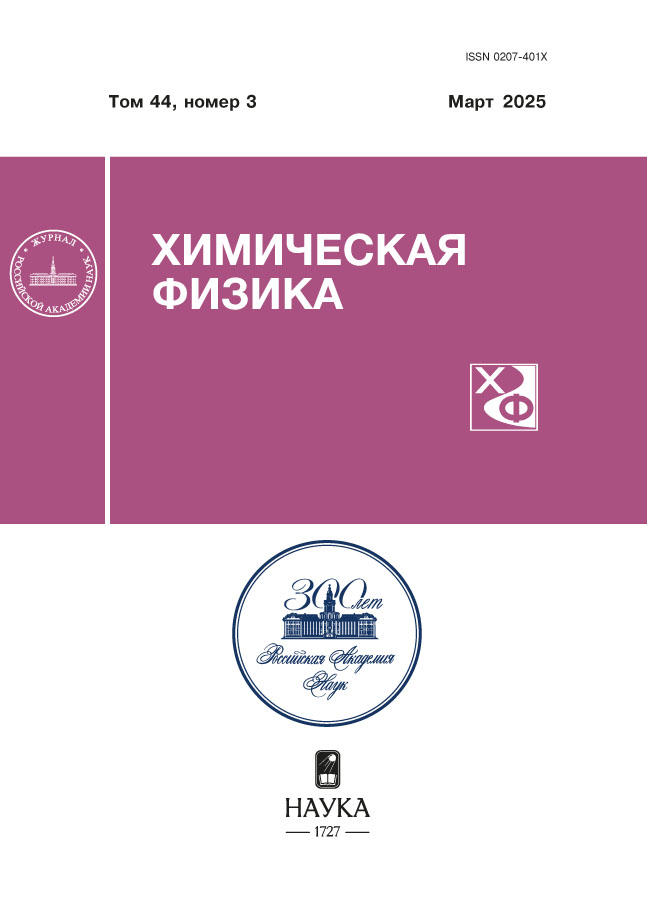Магнитные наночастицы как платформа для доставки фотосенсибилизатора метиленового синего в опухолевые клетки НСТ116
- Авторы: Нгуен М.Т.1, Маркова А.А.1, Батчаева Б.Б.1, Горобец М.Г.1, Торопцева А.В.1, Мотякин М.В.1, Абдуллина М.И.1, Бычкова А.В.1
-
Учреждения:
- Институт биохимической физики им. Н.М. Эмануэля Российской академии наук
- Выпуск: Том 44, № 3 (2025)
- Страницы: 106-110
- Раздел: Химическая физика наноматериалов
- URL: https://ter-arkhiv.ru/0207-401X/article/view/679474
- DOI: https://doi.org/10.31857/S0207401X25030119
- ID: 679474
Цитировать
Полный текст
Аннотация
Синтезированы гибридные наноразмерные системы на основе магнитных наночастиц оксидов железа (НЧОЖ) и человеческого сывороточного альбумина (ЧСА), содержащие метиленовый синий (МС) как модельный фотосенсибилизатор. Полученные наносистемы ЧСА@НЧОЖ были охарактеризованы по размеру и составу с помощью спектрофотометрии УФ- или видимой области (в частности, с использованием метода Брэдфорда), методов динамического светорассеяния и электронного магнитного резонанса. Выполнено исследование темновой и фотоиндуцированной цитотоксичности МС, НЧОЖ, ЧСА@НЧОЖ, МС–НЧОЖ, МС–(ЧСА@НЧОЖ) на опухолевых клетках аденокарциномы толстой кишки человека НСТ116. В условиях эксперимента разница между темновым и световым действием наносистем на клетки была значительно расширена при иммобилизации фотосенсибилизатора на поверхность частиц-носителей по сравнению со свободным фотосенсибилизатором в эквивалентных концентрациях.
Полный текст
Об авторах
М. Т. Нгуен
Институт биохимической физики им. Н.М. Эмануэля Российской академии наук
Email: anna.v.bychkova@gmail.com
Россия, Москва
А. А. Маркова
Институт биохимической физики им. Н.М. Эмануэля Российской академии наук
Email: anna.v.bychkova@gmail.com
Россия, Москва
Б. Б. Батчаева
Институт биохимической физики им. Н.М. Эмануэля Российской академии наук
Email: anna.v.bychkova@gmail.com
Россия, Москва
М. Г. Горобец
Институт биохимической физики им. Н.М. Эмануэля Российской академии наук
Email: anna.v.bychkova@gmail.com
Россия, Москва
А. В. Торопцева
Институт биохимической физики им. Н.М. Эмануэля Российской академии наук
Email: anna.v.bychkova@gmail.com
Россия, Москва
М. В. Мотякин
Институт биохимической физики им. Н.М. Эмануэля Российской академии наук
Email: anna.v.bychkova@gmail.com
Россия, Москва
М. И. Абдуллина
Институт биохимической физики им. Н.М. Эмануэля Российской академии наук
Email: anna.v.bychkova@gmail.com
Россия, Москва
А. В. Бычкова
Институт биохимической физики им. Н.М. Эмануэля Российской академии наук
Автор, ответственный за переписку.
Email: anna.v.bychkova@gmail.com
Россия, Москва
Список литературы
- Chen Q., Liu Z. // Adv. Mater. 2016. V. 28. № 47. P. 10557.
- Israel L.L., Galstyan A., Holler E. et al. // J. Control. Release. 2020. V. 320. P. 45.
- Chubarov A.S. // Magnetochemistry. 2022. V. 8. № 2. P. 13.
- Бердникова Н.Г., Донцов А.Е., Ерохина М.В. и др. // Хим. физика. 2019. Т. 38. № 12. С. 48. https://doi.org/10.1134/S0207401X19120045
- Menshutina N.V., Uvarova A.A., Mochalova M.S. et al. // Russ J. Phys Chem. B. 2023. V. 17. № 7. P. 1507. https://doi.org/10.1134/S1990793123070163
- Колыванова М.А., Климович М.А., Дементьева О.В. и др. // Хим. физика. 2023. Т. 42. № 1. С. 64. https://doi.org/10.31857/S0207401X23010065
- Поволоцкий А.В., Солдатова Д.А., Лукьянов Д.А., Соловьёва Е.В. // Хим. физика. 2023. T. 42. № 12. С. 70. https://doi.org/10.31857/S0207401X23120087
- Tardivo J.P., Del Giglio A., de Oliveira C.S. et al. // Photodiagnosis Photodyn. Ther. 2005. V. 2. № 3. P. 175.
- Zhang Y., Ye Z., He R. et al. // Colloids Surf. B. 2023. V. 224. P. 113201.
- Toledo V.H., Yoshimura T.M., Pereira S.T. et al. // J. Photochem. Photobiol. B. 2020. V. 209. P. 111956.
- Rodrigues J.A., Correia J.H. // Intern. J. Mol. Sci. 2023. V. 24. P. 12204.
- Бурцев И.Д., Егоров А.Е., Костюков А.А. и др. // Хим. физика. 2022. Т. 41. № 2. С. 41. https://doi.org/10.31857/S0207401X22020029
- Климович М.А., Сажина Н.Н., Радченко А.Ш. и др. // Хим. физика. 2021. Т. 40. № 2. С. 33. https://doi.org/10.31857/S0207401X21020084
- Bychkova A.V., Yakunina M.N., Lopukhova M.V. et al. // Pharmaceutics. 2022. V. 14. № 12. P. 2771.
- Nguyen M.T., Guseva E.V., Ataeva A.N. et al. // Intern. J. Mol. Sci. 2023. V. 24. P. 7995.
- Далидчик Ф.И., Лопатина О.А., Ковалевский С.А. и др. // Хим. физика. 2024. Т. 43. № 2. С. 92.
- Hu Y.-J., Li W., Liu Y. et al. // J. Pharm. Biomed. Anal. 2005. V. 39. № 3–4. P. 740.
Дополнительные файлы












